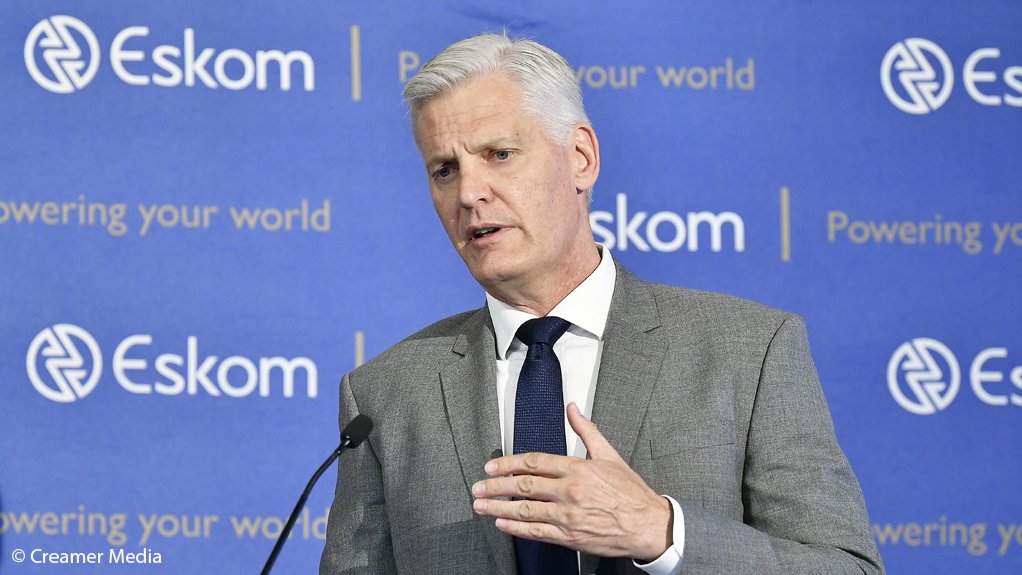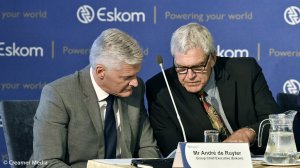The board at State-owned electricity utility Eskom has sanctioned a proposal to migrate the group’s unreliable coal fleet to a ‘philosophy maintenance’ model, whereby generation units are serviced in strict adherence with prescribed maintenance schedules in a bid to break the current vicious cycle of unplanned breakdowns.
CEO Andre de Ruyter said on Friday that the model – which was approved during the board’s January 29 meeting and which had also been canvassed with Eskom’s shareholder – would increase the risk of load-shedding for the coming 18 months at least. It would also, however, improve the longer-term performance of the fleet, which had been undermaintained for years.
The utility’s coal-fired power stations have become increasingly unreliable, which has led to a steep increase in load-shedding since September. On December 9, Eskom was even forced to declare Stage 6, or 6 000 MW of simultaneous cuts, for the first time in its 96-year history.
The trend, as measured by the coal fleet’s energy availability factor (EAF), has been on a downward trajectory for years and the outlook would remain unfavourable unless the generation units were either shut or properly repaired. For the year-to-date, the EAF has been a paltry 68%, well below a 70% internal Eskom target, and it dipped below 60% in December.
Speaking at a ‘state of the system’ media briefing, De Ruyter said that, having received board approval for the transition to philosophy maintenance, the intention now was to craft a “fully-fledged” plan and to assess what impact the change in approach would have on security of supply. This plan would again require board and shareholder sanction.
In the interim, Eskom would pilot the new model at Hendrina Unit 7, Kendal Unit 5, Lethabo Unit 6, Medupi Unit 3; Kriel Unit 5 and Majuba Unit 1, which together represented 3 200 MW of capacity that would be down for long-term maintenance.
These repairs, together with ongoing unplanned breakdowns, would increase the immediate risk of load-shedding and/or increase Eskom’s reliance on the country’s expensive open-cycle gas turbines (OCGTs). For the year to date, Eskom had limited the use of these diesel-fuelled generators to R2.5-billion, against a R6.9-billion budget. However, deployment could climb materially in the remaining months of the utility’s financial year, which ends on March 31.
COO Jan Oberholzer said the units included in the initial philosophy-maintenance trial run would remain shut until they had been fully serviced in line with guidelines outlined by the original equipment manufacturers (OEMs). Hitherto, long-lead repairs had been either deferred or rushed in order to return units to service as quickly as possible – a practice that had resulted in a high level of post-maintenance breakdowns.
Oberholzer indicated that these initial repairs would be conducted by in-house teams, but announced that, in future, Eskom intended entering into long-term partnership agreements with the OEMs that had supplied the equipment to the coal plants in the first instance. Such partnerships, he argued, should widen and deepen Eskom’s maintenance skills pool and improve the quality of maintenance being performed.
Eskom would continue to insist on its transformation and localisation objectives being met by the OEMs and Oberholzer reported that several companies had already made specific proposals to Eskom on how its maintenance could be improved.
“Going forward, philosophy maintenance and mid-life refurbishment will not be compromised,” he insisted, while acknowledging that the approach could result in reduced capacity for the system in the short to medium term.
CREATING HEADROOM?
In parallel, the utility was assessing various demand- and supply-side options that could be introduced simultaneously with the philosophy-maintenance plan to create the “headroom” needed to limit load-shedding.
Nevertheless, De Ruyter stressed that it was unlikely that load-shedding could be entirely avoided.
Various demand-side solutions were being assessed, including the reintroduction of radio and television alerts, which had proved valuable previously in reducing demand during period of system stress.
The board had also given the executives the go-ahead to negotiate the purchase of power from those mining and industrial companies that were in a position to sell electricity into the grid, or to reduce their load when the supply/demand balance tightened.
He refused to be drawn on how much capacity could be secured from such firms, nor on the price Eskom was willing to pay for such relief. However, all demand- and supply contracts would be pursued only where the business case was advantageous for the system and if they did not place Eskom under additional financial distress.
Eskom was even initiating studies into the potential for extending the lives of the remaining operating units at Hendrina, Camden and Grootvlei “beyond their previously approved shutdown dates”.
Oberholzer indicated that one option could even be to assess whether there was potential to convert the units from coal to gas. Likewise, Eskom was keen to convert its OCGT plants from diesel to gas.
A project management office, led by Andrew Etzinger, had been established to investigate all the demand- and supply-side options.
In addition, work was under way to address defects at Medupi and Kusile, where those units that had entered into operation continued to perform well below nameplate.
Five of the six Medupi units had entered commercial operation, but only one Kusile unit was currently in commercial operation, with two more having been synchronised to the grid. All 12 Medupi and Kusile units are expected to be fully operational in early 2023.
“The new-build focus currently is to ensure that we extract value from the investments we have made and to get a return on that investment.”
EMAIL THIS ARTICLE SAVE THIS ARTICLE ARTICLE ENQUIRY
To subscribe email subscriptions@creamermedia.co.za or click here
To advertise email advertising@creamermedia.co.za or click here













